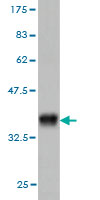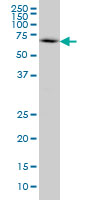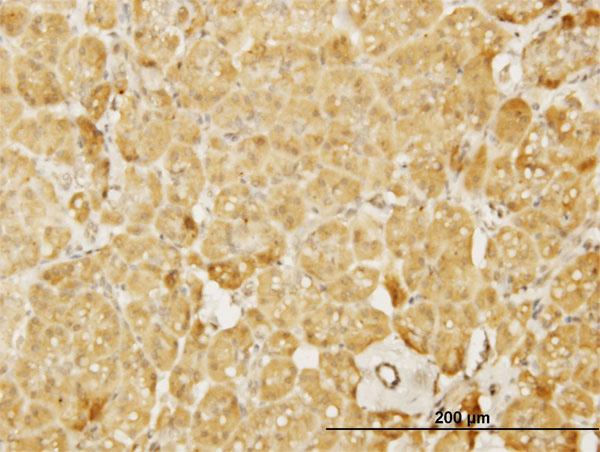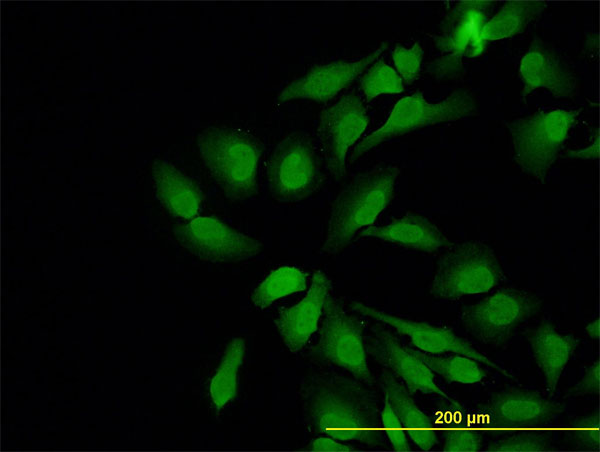WASL Antibody (monoclonal) (M04)
Mouse monoclonal antibody raised against a partial recombinant WASL.
- 产品详情
- 实验流程
- 背景知识
Application
| WB, IHC, IF |
|---|---|
| Primary Accession | O00401 |
| Other Accession | NM_003941 |
| Reactivity | Human |
| Host | mouse |
| Clonality | monoclonal |
| Isotype | IgG2b Kappa |
| Clone Names | 5F4 |
| Calculated MW | 54827 Da |
| Gene ID | 8976 |
|---|---|
| Other Names | Neural Wiskott-Aldrich syndrome protein, N-WASP, WASL |
| Target/Specificity | WASL (NP_003932, 97 a.a. ~ 184 a.a) partial recombinant protein with GST tag. MW of the GST tag alone is 26 KDa. |
| Dilution | WB~~1:500~1000 IHC~~1:100~500 IF~~1:50~200 |
| Format | Clear, colorless solution in phosphate buffered saline, pH 7.2 . |
| Storage | Store at -20°C or lower. Aliquot to avoid repeated freezing and thawing. |
| Precautions | WASL Antibody (monoclonal) (M04) is for research use only and not for use in diagnostic or therapeutic procedures. |
For Research Use Only. Not For Use In Diagnostic Procedures.
Provided below are standard protocols that you may find useful for product applications.
BACKGROUND
The Wiskott-Aldrich syndrome (WAS) family of proteins share similar domain structure, and are involved in transduction of signals from receptors on the cell surface to the actin cytoskeleton. The presence of a number of different motifs suggests that they are regulated by a number of different stimuli, and interact with multiple proteins. Recent studies have demonstrated that these proteins, directly or indirectly, associate with the small GTPase, Cdc42, known to regulate formation of actin filaments, and the cytoskeletal organizing complex, Arp2/3. The WASL gene product is a homolog of WAS protein, however, unlike the latter, it is ubiquitously expressed and shows highest expression in neural tissues. It has been shown to bind Cdc42 directly, and induce formation of long actin microspikes.
REFERENCES
Regulation of actin polymerization and adhesion-dependent cell edge protrusion by the Abl-related gene (Arg) tyrosine kinase and N-WASp. Miller MM, et al. Biochemistry, 2010 Mar 16. PMID 20146487.The rate of N-WASP exchange limits the extent of ARP2/3-complex-dependent actin-based motility. Weisswange I, et al. Nature, 2009 Mar 5. PMID 19262673.The Toca-1-N-WASP complex links filopodial formation to endocytosis. Bu W, et al. J Biol Chem, 2009 Apr 24. PMID 19213734.Overexpression of N-WASP in the brain of human epilepsy. Xiao F, et al. Brain Res, 2008 Oct 3. PMID 18708039.Inhibition of cytokinesis by wiskostatin does not rely on N-WASP/Arp2/3 complex pathway. Bompard G, et al. BMC Cell Biol, 2008 Jul 30. PMID 18667055.
终于等到您。ABCEPTA(百远生物)抗体产品。
点击下方“我要评价 ”按钮提交您的反馈信息,您的反馈和评价是我们最宝贵的财富之一,
我们将在1-3个工作日内处理您的反馈信息。
如有疑问,联系:0512-88856768 tech-china@abcepta.com.























 癌症的基本特征包括细胞增殖、血管生成、迁移、凋亡逃避机制和细胞永生等。找到癌症发生过程中这些通路的关键标记物和对应的抗体用于检测至关重要。
癌症的基本特征包括细胞增殖、血管生成、迁移、凋亡逃避机制和细胞永生等。找到癌症发生过程中这些通路的关键标记物和对应的抗体用于检测至关重要。 为您推荐一个泛素化位点预测神器——泛素化分析工具,可以为您的蛋白的泛素化位点作出预测和评分。
为您推荐一个泛素化位点预测神器——泛素化分析工具,可以为您的蛋白的泛素化位点作出预测和评分。 细胞自噬受体图形绘图工具为你的蛋白的细胞受体结合位点作出预测和评分,识别结合到自噬通路中的蛋白是非常重要的,便于让我们理解自噬在正常生理、病理过程中的作用,如发育、细胞分化、神经退化性疾病、压力条件下、感染和癌症。
细胞自噬受体图形绘图工具为你的蛋白的细胞受体结合位点作出预测和评分,识别结合到自噬通路中的蛋白是非常重要的,便于让我们理解自噬在正常生理、病理过程中的作用,如发育、细胞分化、神经退化性疾病、压力条件下、感染和癌症。









